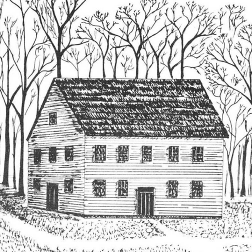
|
Wintonbury Parish was established in 1736 on the petition of 52 men. Previously they and their families had walked from what is now Bloomfield to Windsor, Simsbury, and Farmington in order to hear a learned preacher explain the mysteries of the relationship between God and man. By 1737 the first meeting house was erected and the first official gathering of the Congregational Church took place on February 14, 1738. The first pastor was Hezekiah Bissell who was ordained to this parish in 1738. He remained for 45 years, until death, and presided over the earliest theological conflicts in this church, related to the church covenant. At the end of Reverend Bissell’s career, and on into the 1800’s, there was a continuing theological struggle in which some Congregational Church leadership proposed restricting the freedom to worship. Finally, in 1818, a new state constitution abolished the ties between church and state, permitting all to worship as they pleased. Sunday School was added in 1827. Wintonbury Parish became the Town of Bloomfield in 1835. Our current meeting house was built in 1858. |
|
History |

|
The First Congregational Church In Bloomfield Bloomfield, Conecticut United Church of Christ |

|
The First Congregational Church In Bloomfield |
|
Record of early marriages in Wintonbury Parish. Senior church members and those of you familiar with the streets in Bloomfield will recognize many of the last names. |

|
Although the record shows that some slaves were owned by Bloomfield residents, there were many in our church who were among the early abolitionists, and who assisted in operating the underground railroad to help runaway slaves get to freedom in Canada. After the Civil War, our church and community largely depended on agriculture as a livelihood. That would change rapidly in the 1950’s. Now, farm land was sold for industrial and residential development. Previously a largely Christian community, there was a substantial influx of Jews. Also, the community which once assisted with the underground railroad was now becoming home to thousands of black middle class families seeking home ownership and better schools. There were persons in Bloomfield public life who opposed racial bigotry and who desired a successful outcome to integration of the races. Several of these leaders came from our church, acting out their religious convictions in the societal change. Our church today sees a gradual increase in the participation of black members and worshippers. Weddings and baptisms are celebrated here by black members and friends. The deep theological struggles seem to be behind us, women and men of diverse backgrounds share in the leadership of the church, and members continue to take active roles in community affairs. Like our founders, we strive to respond to the events of our time with the insight, the sensitivity and the power of the faith which names Jesus Christ as Lord, and God as Father of us all. Excerpted and paraphrased from Hezekiah’s Children written in 1989 by the Reverend Roscoe F. Metzger, pastor from 1946-1977. |